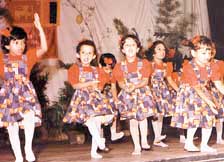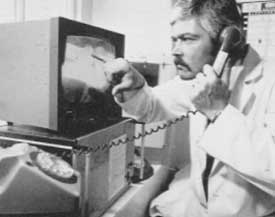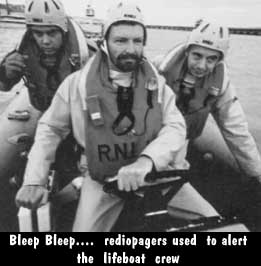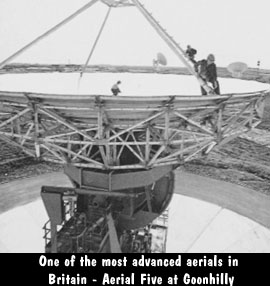



![]()
| Hello Children,
It's time to go to school and into a higher grade. Another year has ended and we can look back at all the happy and sad experiences we had and lock them away in our memory forever. Many of you may not keep a diary, but it's a lot of fun to write down all those good and bad moments in your life. It's like telling someone all that had happend. Anne Frank a little Jewish girl kept a diary when she was hiding from the Germans. Though she didn't survive her diary told the story of this girl. In your diary you can even jot down little verses and poems. It can also be very entertaining for you when you grow older and read about the things you did when you were young. So keep writing. Until next week, Aunty Sunshine |
 |
 |
 |
 |
Communica tions can mean any of the numerous ways in which a message is passed from one person to another. It can be a simple face-to-face conversation, or a speaker addressing a large crowd. It can be the tremendous scope of 'the media'— the press, TV and radio —or it can be a short message sent from ship to shore by Morse code.
Arguably the most important of all, however, is the development of the telephone, which revolutionised communications when it was first invented, and which now sends millions of instantaneous messages all over the world every second of the day and night.
MAKING A CALL
When you make a call from an ordinary household telephone, the first thing you do is lift the handset. This is sometimes called 'the receiver', but actually that name isn't very accurate, as it houses both the receiver and the transmitter. The receiver is in the ear-piece, and the transmitter in the mouthpiece.
Lifting the receiver applies voltage to the line, and connects the telephone to the local exchange. The next step is to indicate the number you want, and this can be done by dialling, or on more modern telephones by pressing numbered buttons.
Either way, the end result is that a series of electronic pulses are sent along the wires to the exchange, where they activate the switching mechanism which directs the call towards the number you want. If you're making a long distance call, it might have to pass through a number of exchanges before you are connected — which makes it all the more amazing when you think that you hear the ringing tone only seconds after you have dialled!
When you speak into the mouthpiece your voice makes a diaphragm vibrate. Behind the diaphragm are loosely packed grains of carbon, which act as a microphone. A low voltage current is passing through the grains, and the vibration of the diaphragm causes the current to fluctuate, because the electrical resistance of the carbon grains is constantly altering. These fluctuations form the voice signals which are transmitted to the number you have dialled.
At the other end, the signals pass through the coils of two electromagnets, and cause their magnetism to fluctuate also. This makes a metal diaphragm in the ear-piece vibrate, and its vibration generates sound waves, which are the exact replica of the words you spoke into your mouthpiece — hundreds, or even thousands of miles away!
BELL AND EDISON
It was in 1876 that Alexander Graham Bell became the first person to
transmit and receive speech by telephone, an invention  which
arose out of his pioneering work with the problems of deafness. Another
great inventor, Thomas Alva Edison, also worked on the idea, and patented
a telephone which worked on a different principle. The first true, working
telephones utilised the best points of each of the two inventions.
which
arose out of his pioneering work with the problems of deafness. Another
great inventor, Thomas Alva Edison, also worked on the idea, and patented
a telephone which worked on a different principle. The first true, working
telephones utilised the best points of each of the two inventions.
THE POST OFFICE TOWER
Playing its vital role in London's communications system for twenty-four hours every day, the Post Office Tower is the tallest building in Britain. Its storm warning radar scanner, perched right on top, is 189 metres from the ground.
Why does the Tower have to be so high?
Well, it is because its horn and dish shaped aerials — which you can clearly see in the picture — have to be above the level of the buildings round about. This is because they receive and transmit microwave radio beams, which need an obstacle-free path to their destinations.
Each of these beams is capable of carrying over a thousand telephone calls at once, and they are transmitted through a series of relay stations, because each beam has a range of only about thirty miles or so.
Among the Post Office Tower's other claims to fame is the unique revolving restaurant— in the section above the aerials — which revolves once every half hour, and gives diners a magnificent view of London.
The official name of the Post Office Tower is British Telecom Tower.
BLEEP, BLEEP...
 The
widespread use of the telephone means that most people in businesses and
other organisations can be contacted quickly when they are needed. But
there are still many situations where people have to spend at least part
of the day away from their own telephone.
The
widespread use of the telephone means that most people in businesses and
other organisations can be contacted quickly when they are needed. But
there are still many situations where people have to spend at least part
of the day away from their own telephone.
A large building site might be one example, where an engineer could be working for many hours a day at different parts of the site. Also in a hospital, where doctors move from ward to ward, it is not always easy for the telephone switchboard operator to locate a particular doctor when an urgent call comes through.
These problems have been solved by the use of radiopagers. These devices
are miniature radio receivers, and they can be  carried
around easily by the user, as you can see in the picture. When the user
is required urgently, the radiopager is activated by someone dialling its
exclusive ten-digit number, and the device gives off a loud bleeping sound.
carried
around easily by the user, as you can see in the picture. When the user
is required urgently, the radiopager is activated by someone dialling its
exclusive ten-digit number, and the device gives off a loud bleeping sound.
Thus alerted, the user can make his way to his office to take the message, or can telephone in from the nearest telephone.
This picture shows a very important use of radiopagers. They are being used in Brighton to alert the lifeboat crew when an emergency arises.
TV BY TELEPHONE
Diagnosis of a broken limb by telephone might sound a rather risky medical practice, but not so when the doctor has the advantage of a clear x-ray picture of the injury on his TV screen.
This system is being pioneered at the Royal Cornwall Hospital in Truro, which is linked by what is called slow scan TV to hospitals in West Cornwall and the Scillies.
It means that doctors in a small hospital can have the benefit of the advice of a consultant in the larger hospital almost immediately when, say, an accident victim is brought in.
The pictures are sent in digital form over a telephone network, and trials are proving that the picture comes through with excellent definition.
Some of the many other possible uses are in security work and traffic surveillance, and it looks as though slow scan TV will be widely used in the future.
LOOKING TO THE FUTURE
The Post Office Tower might be tall, but it's not quite so high off the ground as the other important relay stations of today — the telecommunications satellites.
The first communications satellite, Telstar, was launched in 1962— enjoying such tremendous public interest that it had a pop tune named after it — and since then the network of satellites has grown and grown. They now relay facts, figures and pictures all over the world, every minute of the day.
Six out of ten international telephone calls to and from Britain are relayed by satellite, and the calls are handled at earth .stations, of which the best known is at Goonhilly Downs in Cornwall.
Here you can see one of the most advanced aerials in Britain—Aerial Five at Goonhilly — receiving final checks by engineers before it goes into operation.
Return to Mirror Magazine contents
![]()
Please send your comments and suggestions on this web site to
info@suntimes.is.lk or to
webmaster@infolabs.is.lk